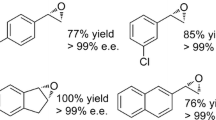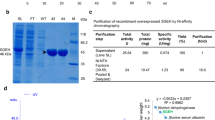Abstract
The enantioselective hydrolysis of eight racemic styrene oxide derivatives has been investigated by using the recombinant cell containing epoxide hydrolase (EH) of Caulobacter crescentus. Some styrene oxide derivatives were hydrolyzed via enantioconvergent manner so that enantiopure diol products could be prepared with a 100% theoretical yield. The recombinant cell containing C. crescentus EH exhibited an ability to hydrolyze racemic p-chlorostyrene oxide the most enantioconvergently, thus affording the formation of the corresponding (R)-diol with enantiomeric excess (ee) as high as 95% and a 72% yield in preparative-scale (16.8 g/l) bioconversion.






Similar content being viewed by others
References
Breuer M, Ditrich K, Habicher T, Hauer B, Kesseler M, Sturmer R, Zelinski T (2004) Industrial methods for the production of optically active intermediates. Angew Chem Int Ed 43:788–824
Faber K, Kroutil W (2002) Stereoselectivity in biocatalytic enantioconvergent reactions and a computer program for its determination. Tetrahedron Asymmetry 13:377–382
Genzel Y, Archelas A, Broxterman QB, Schulze B, Furstoss R (2002) Microbiological transformation 50: selection of epoxide hydrolases for enzymatic resolution of 2-, 3- or 4-pyridyloxirane. J Mol Catal B: Enzym 16:217–222
Hwang SH, Hyun HJ, Lee BJ, Park YS, Choi CY, Han J, Joo H (2005) Screening from the genome databases: novel epoxide hydrolase from Caulobacter crescentus. J Microbiol Biotechnol 16:32–36
Hwang S, Hyun H, Lee B, Park Y, Lee EY, Choi C (2006) Purification and characterization of recombinant Caulobacter crescentus epoxide hydrolase. Biotechnol Bioprocess Eng 11:282–287
Kasai N, Suzuki T, Furukawa Y (1998) Chiral C3 epoxides and halohydrins: Their preparation and synthetic application. J Mol Catal B: Enzym 4:237–252
Kim HS, Lee OK, Hwang S, Kim BJ, Lee EY (2008) Biosynthesis of (R)-phenyl-1,2-ethanediol from racemic styrene oxide by using bacterial and marine fish epoxide hydrolases. Biotechnol Lett 30:127–133
Lee EY, Shuler ML (2007) Molecular engineering of epoxide hydrolase and its application to asymmetric and enantioconvergent hydrolysis. Biotechnol Bioeng 98:318–327
Lutje Spelberg JH, Rink R, Kellogg RM, Janssen DB (1998) Enantioselectivity of a recombinant epoxide hydrolase from Agrobacterium radiobacter. Tetrahedron Asymmetry 9:459–466
Manoj KM, Archelas A, Barati J, Furstos R (2001) Microbiological transformations 45. A green chemistry preparative scale synthesis of enantiopure building blocks of Eliprodil: elaboration of a high substrate concentration epoxide hydrolase-catalyzed hydrolytic kinetic resolution process. Tetrahedron 57:695–701
Monterde MI, Lombard M, Archelas A, Cronin A, Arand M, Furstoss R (2004) Enzymatic transformations. Part 58: Enantioconvergent biohydrolysis of styrene oxide derivatives catalysed by the Solanum tuberosum epoxide hydrolase. Tetrahedron Asymmetry 15:2801–2805
Moussou P, Archelas A, Baratti J, Furstoss R (1998) Microbiological transformations. Part 39: determination of the regioselectivity occurring during oxirane ring opening by epoxide hydrolases: a theoretical analysis and a new method for its determination. Tetrahedron Asymmetry 9:1539–1547
Orru RVA, Archelas A, Furstoss R, Faber K (1998) Epoxide hydrolases and their synthetic applications. Adv Biochem Eng Biotechnol 63:145–167
Steinreiber A, Mayer SF, Saf R, Faber K (2001) Biocatalytic asymmetric and enantioconvergent hydrolysis of trisubstituted oxiranes. Tetrahedron Asymmetry 12:1519–1528
Strauss UT, Felfer U, Faber K (1999) Biocatalytic transformation of racemates into chiral building blocks in 100% chemical yield and 100% enantiomeric excess. Tetrahedron Asymmetry 10:107–117
Acknowledgments
This work was supported by the Marine and Extreme Genome Research Center Program, Ministry of Marine Affairs and Fisheries, Republic of Korea.
Author information
Authors and Affiliations
Corresponding author
Rights and permissions
About this article
Cite this article
Hwang, S., Choi, C.Y. & Lee, E.Y. Enantioconvergent bioconversion of p-chlorostyrene oxide to (R)-p-chlorophenyl-1,2-ethandiol by the bacterial epoxide hydrolase of Caulobacter crescentus . Biotechnol Lett 30, 1219–1225 (2008). https://doi.org/10.1007/s10529-008-9668-7
Received:
Revised:
Accepted:
Published:
Issue Date:
DOI: https://doi.org/10.1007/s10529-008-9668-7




